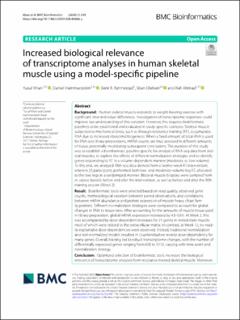| dc.description.abstract | Abstract
Background: Human skeletal muscle responds to weight-bearing exercise with signifcant inter-individual diferences. Investigation of transcriptome responses could improve our understanding of this variation. However, this requires bioinformatic pipelines to be established and evaluated in study-specifc contexts. Skeletal muscle subjected to mechanical stress, such as through resistance training (RT), accumulates RNA due to increased ribosomal biogenesis. When a fxed amount of total-RNA is used for RNA-seq library preparations, mRNA counts are thus assessed in diferent amounts of tissue, potentially invalidating subsequent conclusions. The purpose of this study was to establish a bioinformatic pipeline specifc for analysis of RNA-seq data from skeletal muscles, to explore the efects of diferent normalization strategies and to identify genes responding to RT in a volume-dependent manner (moderate vs. low volume). To this end, we analyzed RNA-seq data derived from a twelve-week RT intervention, wherein 25 participants performed both low- and moderate-volume leg RT, allocated to the two legs in a randomized manner. Bilateral muscle biopsies were sampled from m. vastus lateralis before and after the intervention, as well as before and after the ffth training session (Week 2).
Result: Bioinformatic tools were selected based on read quality, observed gene counts, methodological variation between paired observations, and correlations between mRNA abundance and protein expression of myosin heavy chain family proteins. Diferent normalization strategies were compared to account for global changes in RNA to tissue ratio. After accounting for the amounts of muscle tissue used in library preparation, global mRNA expression increased by 43–53%. At Week 2, this was accompanied by dose-dependent increases for 21 genes in rested-state muscle, most of which were related to the extracellular matrix. In contrast, at Week 12, no readily explainable dose-dependencies were observed. Instead, traditional normalization and non-normalized models resulted in counterintuitive reverse dose-dependency for many genes. Overall, training led to robust transcriptome changes, with the number of diferentially expressed genes ranging from 603 to 5110, varying with time point and normalization strategy.
Conclusion: Optimized selection of bioinformatic tools increases the biological relevance of transcriptome analyses from resistance-trained skeletal muscle. Moreover,normalization procedures need to account for global changes in rRNA and mRNA abundance. | en_US |

